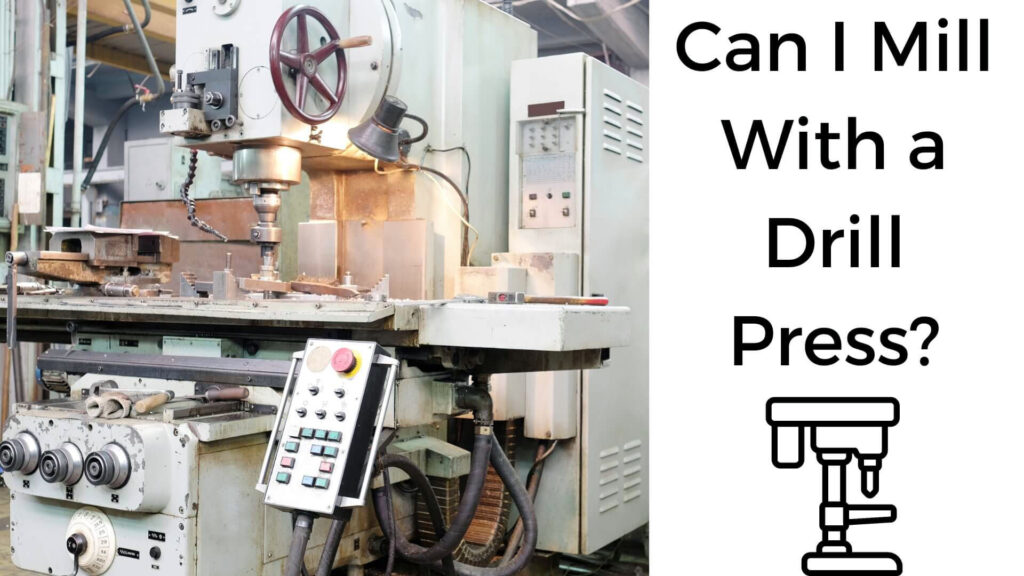If you’ve ever found yourself staring at your drill press and wondering if it can double as a milling machine, you’re not alone. Many DIY enthusiasts and hobbyists often explore the versatility of their tools, leading to questions about their capabilities.
In this blog post, I’ll delve into the question: Can I mill with a drill press? I’ll explore the functions of a drill press, its limitations, and how it compares to other tools like routers and milling machines. Additionally, I’ll discuss how to maintain your drill press for optimal performance.
Table of Contents
What is a Drill Press?
A drill press is a versatile tool used primarily for drilling holes in various materials, including wood, metal, and plastic. It features a fixed base and a vertically movable drill head, which holds the drill bit and allows for precise hole placement. Here are some key components of a drill press:
- Base: The sturdy foundation that supports the drill press.
- Column: The vertical post connecting the base to the drill head.
- Drill Head: Houses the motor, chuck, and drill bit.
- Chuck: The mechanism that holds the drill bit securely in place.
- Table: The flat surface where the workpiece is placed, often adjustable for height and angle.
Drill presses are known for their ability to provide consistent depth control and accurate hole placement. They are essential in many woodworking and metalworking shops.
Can I Mill With My Drill Press?
The short answer is yes, but with limitations. While a drill press is primarily designed for drilling, it can perform some milling operations, especially when modified with the right attachments. Here’s how:
Capabilities
- Limited Milling: A drill press can handle light milling tasks, such as cutting shallow slots or grooves in wood and softer materials.
- Using a Milling Bit: With the right milling cutter or bit, you can use a drill press for operations similar to milling. However, it won’t match the performance of a dedicated milling machine.
Limitations
- Depth Control: Unlike milling machines, drill presses typically lack the fine depth control needed for precision milling.
- Feed Rate: The feed rate on a drill press is usually limited, making it difficult to perform extended milling operations.
- Material Compatibility: While a drill press can mill wood and some soft metals, it may struggle with harder materials.
In essence, if you need to perform simple milling operations and are working with softer materials, your drill press can serve as a viable alternative. However, for more complex or heavy-duty milling tasks, a dedicated milling machine would be more appropriate.
Types of Drills for a Drill Press
While a standard drill press is primarily used for drilling, there are specific types of drills that can enhance its milling capabilities:
1. Standard Drill Press
- Typically has a fixed-speed motor and can handle light milling tasks with the right bits.
2. Variable Speed Drill Press
- Offers adjustable speed settings, making it more versatile for different materials and milling operations.
3. Benchtop Drill Press
- Compact and portable, ideal for smaller projects. Suitable for light milling tasks.
4. Floor-Mounted Drill Press
- Larger and more powerful, providing increased stability and better performance for both drilling and light milling.
5. Radial Arm Drill Press
- Allows for more versatility in positioning and can be adjusted for different angles, making it useful for milling and drilling at various orientations.
Drill Press vs. Router
Another tool often compared to a drill press is the router. While both tools can perform similar tasks, they have distinct differences:
| Feature | Drill Press | Router |
|---|---|---|
| Primary Function | Drilling holes | Shaping and cutting edges |
| Bit Type | Drill bits | Router bits |
| Movement | Vertical movement only | Variable movement (up/down, side-to-side) |
| Depth Control | Fixed depth adjustment | Depth adjustment is more precise |
| Material | Wood, metal, plastic | Primarily wood and composites |
When to Use Each Tool
- Use a drill press when you need to drill precise holes or perform light milling tasks on softer materials.
- Use a router for shaping edges, making grooves, or creating intricate designs in wood.
Can I Use My Drill Press for Other Things?
Absolutely! A drill press can be quite versatile and can perform several tasks beyond drilling and light milling:
1. Sanding
By attaching a sanding drum to the drill press, you can easily sand edges and surfaces with uniformity.
2. Shaping
Using specialized bits, a drill press can be used for shaping wood, creating patterns, or adding decorative edges.
3. Mortising
With a mortising attachment, you can create square holes for mortise and tenon joints, essential in furniture making.
4. Tapping
Drill presses can be used to tap threads into drilled holes, especially with a tapping attachment.
5. Inlay Work
A drill press can facilitate inlay work by allowing for precise cuts and placements.
How to Maintain Your Drill Press
Proper maintenance of your drill press is essential for ensuring optimal performance and longevity. Here are some key maintenance tips:
1. Regular Cleaning
- Keep the drill press clean from sawdust, metal shavings, and debris.
- Wipe down the surfaces with a soft cloth to prevent corrosion.
2. Lubrication
- Apply lubricant to the moving parts regularly, including the column and chuck. This will reduce friction and ensure smooth operation.
3. Check for Wear and Tear
- Regularly inspect the drill bits, chuck, and other components for wear and replace them as necessary.
4. Tighten Connections
- Ensure all bolts and screws are tight to prevent vibrations and misalignment during use.
5. Calibrate Settings
- Periodically check and calibrate depth settings and speed adjustments to maintain accuracy.
6. Store Properly
- Store the drill press in a dry, clean environment to avoid rust and damage.
Conclusion
In conclusion, while a drill press is primarily designed for drilling, it can certainly perform some milling tasks, albeit with limitations. Its versatility allows it to serve multiple functions, from drilling and sanding to shaping and tapping. However, for more complex milling operations, investing in a dedicated milling machine or router may be more beneficial.
Understanding the capabilities of your tools and how to maintain them can significantly enhance your woodworking and metalworking projects, leading to more successful and efficient outcomes. So, if you’re considering milling with your drill press, remember to keep its limitations in mind, and enjoy the creative possibilities it offers!

Hey, I am MD Hrithik Hossain, I’m a huge fan of DIY crafts. My workshop is where I spend most of my spare time, and I’m always working on some project. To that end, I’d like to share some of my knowledge and experience with you in power tools, woodworking, and other specialized materials fabrication.
I will guide you with genuine knowledge that can assist you with deciding whether a drill is appropriate according to your requirements or not. If you want to find the best drill and know which type of drill is most suited for your needs, then I can guide you with my expertise. My passion lies in helping others find the correct products they need at an affordable price.


